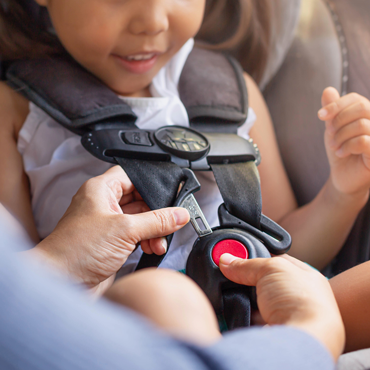As parents, keeping our children safe is always a top priority, especially when we’re on the road. Car crashes remain a leading cause of injury and death for children, but the good news is that proper car seat use significantly reduces the risk. In this blog, we’ll cover key car seat safety recommendations based on guidelines from the American Academy of Pediatrics (AAP), along with practical tips to help families protect their little ones.
Start with Rear-Facing Car Seats
Infants and toddlers should ride in a rear-facing car seat until they reach the highest weight or height allowed by the car seat manufacturer. This position offers the best protection for a child’s head, neck, and spine in the event of a crash. Many rear-facing seats accommodate children until at least age 2, and some go beyond that. Don’t rush to turn the seat forward—keeping your child rear-facing for as long as possible is the safest option.
Make sure the harness straps are positioned at or below your child’s shoulders and are snug enough that you cannot pinch any slack at the shoulder. The chest clip should be at armpit level.
Transition to Forward-Facing Car Seats
Once your child outgrows their rear-facing seat, the next step is a forward-facing car seat with a harness. These seats are designed to keep children secure up to the highest weight or height limit set by the manufacturer, typically until at least age 4. The harness helps distribute crash forces more evenly and reduces the risk of serious injury.
For forward-facing seats, the harness straps should be positioned at or above the shoulders and fit snugly against the body. The straps should be snug enough that you cannot pinch any slack at the shoulder, and the chest clip should rest at armpit level for optimal protection.
Use Booster Seats for Proper Seat Belt Fit
After outgrowing a forward-facing car seat, children should transition to a belt-positioning booster seat. These seats ensure that the vehicle’s seat belt fits properly, which is essential for effective crash protection. Most children will need a booster seat until they are about 4 feet 9 inches tall and between 8 and 12 years old. Remember, every child grows at their own pace, so focus on fit rather than age alone.
The Final Step: Seat Belts
When your child is big enough to use the vehicle’s seat belt alone, ensure they always buckle up correctly. The lap belt should rest snugly across the upper thighs—not the stomach—and the shoulder belt should cross the shoulder and chest, avoiding the neck and face. Proper seat belt use is a habit that will keep your child safe for life.
Keep Kids in the Rear Seat
For maximum safety, all children younger than 13 years should ride in the back seat. The rear seat offers better protection during a crash and reduces the risk of injury from airbags in the front seat.
Proper Installation is Key
Even the best car seat won’t protect your child if it isn’t installed correctly. Always follow the car seat manufacturer’s instructions and consult your vehicle’s owner’s manual. If you’re unsure about your installation, many communities offer car seat inspection stations where certified technicians can help. A correctly installed car seat should not move more than an inch in any direction when tested at the base.
Avoid Common Car Seat Mistakes
It’s easy to make errors when using car seats, but awareness can help you avoid them. Common mistakes include:
- Using a car seat that has expired or been involved in a crash.
- Not securing the car seat tightly enough.
- Incorrectly positioning the harness straps.
- Transitioning to the next stage too soon.
- Dressing children in bulky winter coats while in the car seat, which can create dangerous slack in the harness. Instead, secure the harness snugly and place a blanket or coat over your child after they are buckled in.
Double-checking these details can make all the difference in keeping your child safe.
Trusted Resources for Families
For additional guidance, check out these trusted resources:
- HealthyChildren.org by the AAP
- National Highway Traffic Safety Administration (NHTSA)
- https://www.nhtsa.gov/campaign/safercargov?redirect-safercar-sitewide
- Safe Kids Certification Program
These sites offer step-by-step instructions, videos, and tools to help families make informed decisions about car seat safety.
Final Thoughts
Car seat safety is an investment in your child’s well-being, and following these recommendations can dramatically reduce the risk of injury. Allegro encourages all parents to stay informed, ask questions, and seek help when needed. Remember, every journey—no matter how short—is an opportunity to prioritize safety.
Keep Reading
View All Posts
Helping Kids Breathe Easier
By checking asthma control at every well care visit, we can identify changes early and make sure each child has the support they need to breathe comfortably and stay active.

Protecting Your Newborn from Hepatitis B
Learn why the birth dose of the hepatitis B vaccine matters for every baby.

Community Support for Youth Suicide Prevention
Learn how families can recognize warning signs, foster open communication, and create a supportive environment to help prevent suicide among teens.

